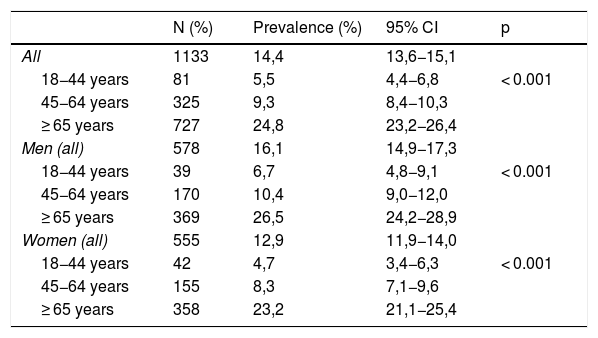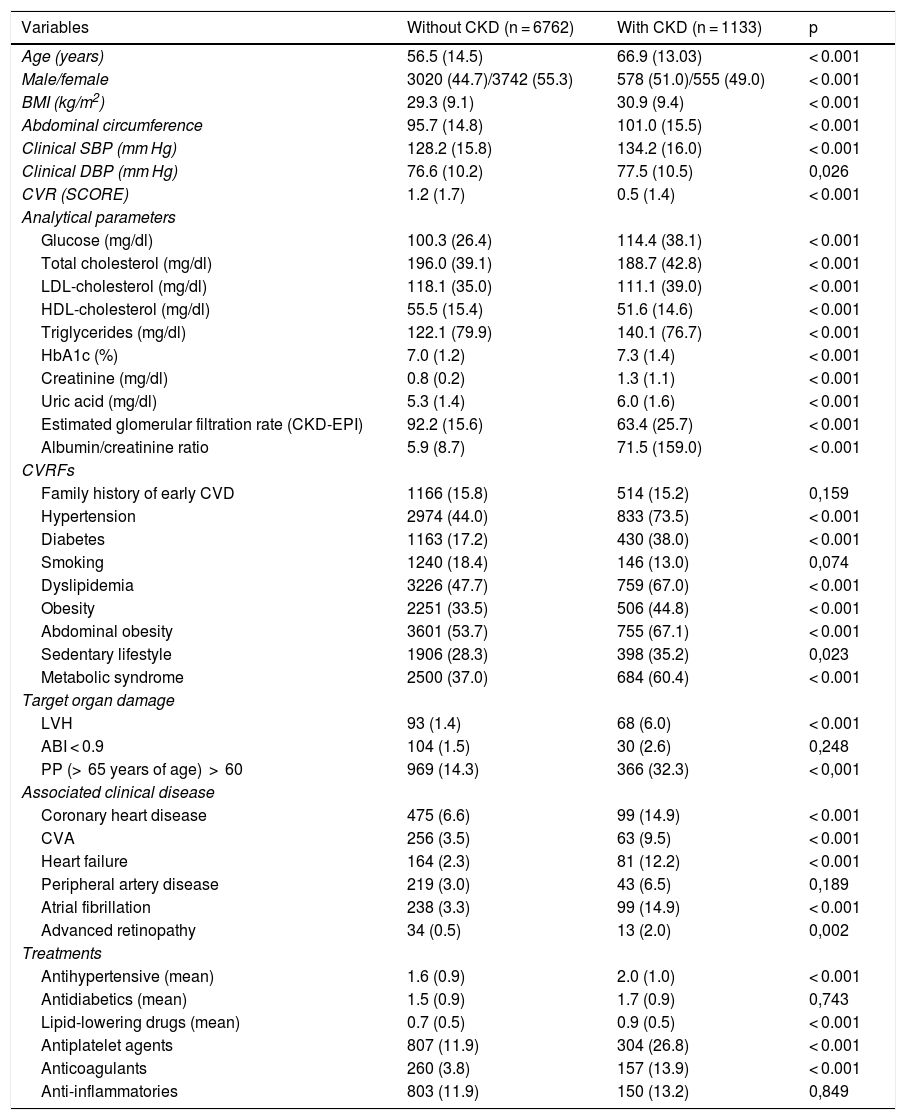To determine the prevalence of chronic kidney disease (CKD) and the factors associated with impaired renal function in the population attended in primary care (PC).
Patients and methodCross-sectional and multicentre study carried out in the baseline patients of the IBERICAN study (Identificación de la poBlación Española de RIesgo CArdiovascular y reNal). CKD was considered with an estimated glomerular filtration (eGF) <60 ml / min/1.73 m2 or elevated albuminuria (≥ 30 mg/g). According to the eGF, the CKD was classified in six stages (1, 2, 3a, 3b, 4 and 5) and according to albuminuria in three stages (A1 or normal / slightly increased, A2 or moderately increased and A3 or severely increased). The clinical characteristics and the relationship of CKD with the main cardiovascular risk factors (CVRF) and other variables of interest were analysed using unconditional logistic regression.
Results7895 patients were included (mean age 57.9 ± 14.8 years; 54.5% women). 14.4% (95% CI: 13.6−15.1) had CKD; 16.1% (95% CI: 14.9−17.3) in men and 12.9% (95% CI: 11.9−14.0) in women. A continuous increase of the prevalence was observed with age (24.8% in ≥ 65 years) and with CVFR aggregation. The variables that were most associated with the probability of suffering CKD were left ventricular hypertrophy (OR: 1.95; p < .001), diabetes (OR: 1.58; p < .001) and hypertension (OR: 1.56; p < .001).
ConclusionsFourteen out of every 100 patients included in the IBERICAN study have CKD. The prevalence of CKD affects a quarter of patients ≥ 65 years and increases exponentially with the aggregation of FRCV.
Conocer la prevalencia de enfermedad renal crónica (ERC) y determinar los factores asociados al deterioro de la función renal en población asistida en atención primaria (AP).
Pacientes y métodoEstudio transversal y multicéntrico realizado en los pacientes basales del estudio IBERICAN (Identificación de la poBlación Española de RIesgo CArdiovascular y reNal). Se consideró ERC a un filtrado glomerular estimado (FGe) < 60 ml/min/1,73 m2 o albuminuria elevada (≥ 30 mg/g). Según el FGe se clasificó la ERC en seis estadios (1, 2, 3a, 3b, 4 y 5) y según la albuminuria en tres (A1 o normal/ligeramente aumentada, A2 o moderadamente aumentada y A3 o gravemente aumentada). Se analizaron las características clínicas y la relación de la ERC con los principales factores de riesgo cardiovascular (FRCV) y otras variables de interés mediante regresión logística no condicional.
ResultadosSe incluyeron 7.895 pacientes (edad media 57,9 ± 14,8 años; 54,5% mujeres). El 14,4% (IC95%: 13,6-15,1) presentaba ERC; en hombres un 16,1% (IC95%:14,9-17,3) y en mujeres un 12,9% (IC95%: 11,9-14,0). Se observó un aumento continuo de la prevalencia con la edad (24,8% en ≥ 65 años) y con la agregación de FRCV. Las variables que más se asociaron a la probabilidad de padecer ERC fueron hipertrofia ventricular izquierda (OR: 1,95; p < 0,001), diabetes (OR: 1,58; p < 0,001) e hipertensión (OR: 1,56; p < 0,001).
ConclusionesCatorce de cada 100 pacientes incluidos en el estudio IBERICAN presenta ERC. La prevalencia de ERC afecta a la cuarta parte de pacientes ≥ 65 años y aumenta exponencialmente con la agregación de FRCV.












